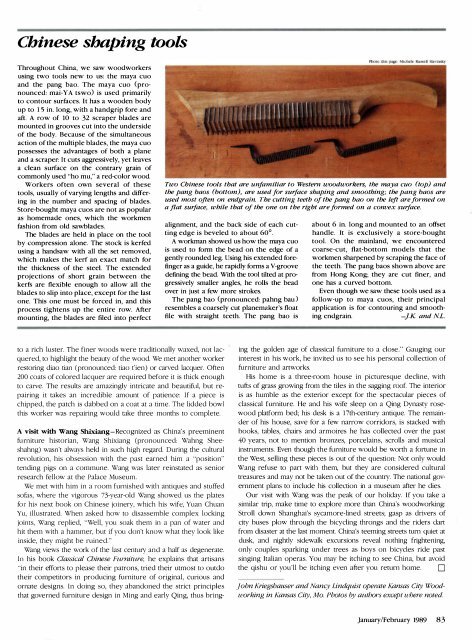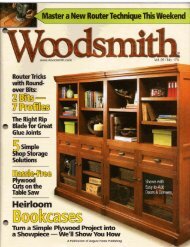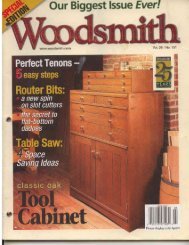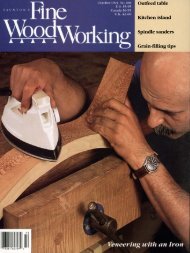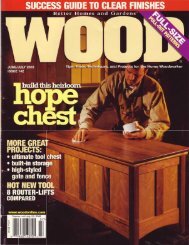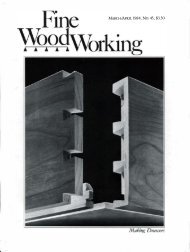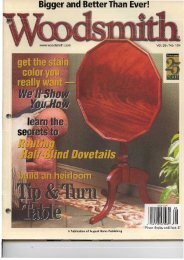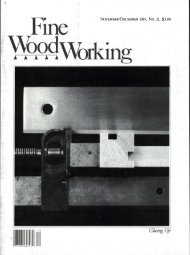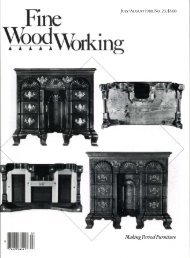joinery shops, such as this one in Beijing (above), supply the oldstylegates, doors and window sashes needed to repair houses inolder neighborhoods. Safety standards in these shops would makemany Western woodworkers shudder: Note the jointer in the foregroundwithout a safety guard or fence and the shopmade tablesawin the background. Finishers line the windowless, dimly lit room(below) with damp straw mats to provide the high humidity environmentnecessary to properly cure their lacquer finishes. In theurban factories, burlap is sometimes used in place of the mats.that clutter our secondhand fu rniture stores. Our guide had difficultyfinding hand-crafted furniture to show us, but eventually helocated the rural Shanghai Art Carving and Engraving Factory, wherea fellow guide had taken President Jimmy Carter some years ago.S hanghai fuctory-This rural factory is like a vision from the earlydays of the industrial revolution in the West. There are rows ofworkbenches lining a long wall of windows. Elsewhere, electricityis used mainly to power scattered fluorescent lights. Nonetheless,the showroom is filled with beautifully made lacquered reproductionfurniture. The company's entire product line is exported. The 250factory employees produce about 100 different designs in Brazilianmahogany, but they also rely on a variety of hardwoods from Thailand.82 Fine WoodworkingPower tools are used for sizing lumber and for roughing outsimple work, but the carving, joinery and finish-planing are doneexclusively with hand tools. We watched a worker deftly fit a doorwith a mitered frame to a cabinet slightly out of square. He sawedbetween the mitered shoulders, down to the tenon, on one faceand repeated this on the opposite face. He brought the joint together,producing a door that was out of square just enough tomatch the cabinet. Chinese planes and saws, unlike Japanese tools,are pushed; the planes are equipped with a crossbar handgrip.Lack of machinelY, however, doesn't prevent Chinese woodworkersfrom accomplishing their tasks quickly and efficiently. They havecreated many homemade tools especially fo r their style of woodworking,such as the "maya cuo" and "pang bao" scrapers, which arediscussed in the sidebar and shown in the photo on the facing page.Most of us knew of the natural lacquer used by the Chinese byits Japanese name "urushi," but we learned that the incrediblytough finish originated in China as "qishu" (pronounced: Cheeshoo). The lacquer is the sap of the Rbus vemicijera, a relative ofpoison sumac. Finishers wear gloves and sleeves to prevent theirsweat and body oils from ruining the finish, but they do nothingadditional to protect themselves. Instead, workers who are allergicto the sap, which causes an irritating rash, are transferred to otherjobs. Several of our group suffered from qishu rashes during ourtrip and took cortisone pills at the first itch, but we still had tocontend with rashes, some pretty nasty, over the next two weeks.Qishu is a major commodity in China, and more than 100,000metric tons are exported annually to Japan. Domestic demand forqishu is high, but not just for its use as a furniture lacquer. TraditionalChinese ceremonial buildings are coated with gesso, coveredwith coarse cloth, then lacquered inside and out-a monumental taskconsidering qishu's finicky curing requirements. Pigments have tobe compatible with qishu's cross-linking chemical bonds or thefinish loses its toughness. The pigments that work best are red cinnabarand malachite, but the first is poisonous and the second isprecious. Chinese finish experts don't consider qishu an effectiveexterior finish, but the 60-year-old lacquer finish we examined onone building showed few signs of cracking or peeling.The workers at the factOlY brush at least four coats of qishu oneach piece of furniture. After each coat, the piece is left in a wetroom to cure overnight. Damp straw mats lining the room maintainthe moisture level necessary for the finish to cure properly.The first coat, a mixture of qishu and a chalky white powder,serves as a paste filler. Between coats, bamboo shoots, which containsilica from the soil, are used to smooth tight corners; ordinarysandpaper smooths the flat surfaces. After the final coat, largebumps are removed with a chisel, and smoothing is done with wetleaves from tile Chinese elm, appropriately referred to as the"sandpaper tree." A thin, final coat is padded on like French polishand then the piece is waxed. These finishers claim that only elmleaves will produce an acceptable finish, but the urban factoriesseem to do fine with wet-or-dry sandpaper.Fish glue in the Forbidden City-In the center of Beijing is thecolossal walled palace of the Ming and Qing dynasties (1368-1644and 1680-1911 respectively), once known as the Forbidden City.This complex housed the imperial family, the bureaucracy and theemperor's eunuchs and concubines. It is now the Palace Museum,housing an unmatched collection of fine Chinese furniture. In themuseum's restoration shops, we found one worker regluing a finewood chair with locking tenon joints. He had disassembled thechair, be ause tile fish glue holding the joints was failing. He wassurprise that we thought such interlocking joints didn't requireglue. After tile repair, tilin layers of hot wax are applied and buffed
Chinese shaping toolsThroughout China, we saw woodworkersusing two tools new to us: the maya cuoand the pang bao. The maya cuo (pronounced:mai-YA tswo) is used primarilyto contour surfaces. It has a wooden bodyup to 15 in. long, with a handgrip fore andaft. A row of 10 to 32 scraper blades aremounted in grooves cut into the undersideof the body. Because of the simultaneousaction of the multiple blades, the maya cuopossesses the advantages of both a planeand a scraper: It cuts aggressively, yet leavesa clean surface on the contrary grain ofcommonly used "ho mu," a red-color wood.Workers often own several of thesetools, usually of varying lengths and differingin the number and spacing of blades.Store-bought maya cuos are not as popularas homemade ones, which the workmenfashion from old sawblades.The blades are held in place on the toolby compression alone. The stock is kerfedusing a handsaw with all the set removed,which makes the kerf an exact match forthe thickness of the steel. The extendedprojections of short grain between thekerfs are flexible enough to allow all theblades to slip into place, except for the lastone. This one must be forced in, and thisprocess tightens up the entire row. Aftermounting, the blades are filed into perfectTwo Chinese tools that are unfamiliar to Western woodworkers, the maya cuo (top) andthe pang baos (bottom), are used for surface shaping and smoothing; the pang baos areused most often on end grain. The cutting teeth of the pang bao on the left are formed ona flat surface, while that of the one on the right are fo rmed on a convex surface.alignment, and the back side of each cuttingedge is beveled to about 60°.A workman showed us how the maya cuois used to form the bead on the edge of agently rounded leg. Using his extended forefingeras a guide, he rapidly forms a V-groovedefining the bead. With the tool tilted at progressivelysmaller angles, he rolls the beadover in just a few more strokes.The pang bao (pronounced: pahng bau )resembles a coarsely cut planemaker's floatfile with straight teeth. The pang bao isabout 6 in. long and mounted to an offsethandle. It is exclusively a store-boughttool. On the mainland, we encounteredcoarse-cut, flat-bottom models that theworkmen sharpened by scraping the face ofthe teeth. The pang baos shown above arefrom Hong Kong; they are cut finer, andone has a curved bottom.Even though we saw these tools used as afo llow-up to maya cuos, their principalapplication is for contouring and smoothingendgrain. -JK and NL.to a rich luster. The finer woods were traditionally waxed, nor lacquered,to highlight the beaury of the wood. We met anodler workerrestoring diao tian (pronounced: [iao t'ien) or carved lacquer. Often200 coats of colored lacquer are required before it is thick enoughto calve. The results are amazingly intricate and beautiful, but repairingit takes an incredible amount of patience: If a piece ischipped, the patch is dabbed on a coat at a time. The lidded bowldlis worker was repairing would take three months to complete.A visit with Wang Shixiang-Recognized as China's preeminentfu rniture historian, Wang Shixiang (pronounced: Wahng Sheeshahng)wasn't always held in such high regard. During the culturalrevolution, his obsession with the past earned him a "pOSition"tending pigs on a commune. Wang was later reinstated as seniorresearch fellow at the Palace Museum.We met with him in a room furnished widl antiques and stuffedsofas, where the vigorous 73-year-old Wang showed us the platesfo r his next book on Chinese joinery, which his wife, Yuan ChuanYu, illustrated. When asked how to disassemble complex lockingjOints, Wang replied, "Well, you soak them in a pan of water andhit them with a hammer, but if you don't know what they look likeinside, they might be ruined."Wang views the work of dle last century and a half as degenerate.In his book Classical Chinese Fumitw'e, he explains that artisans"in their efforts to please their patrons, tried their utmost to outdotheir competitors in producing furniture of original, curious andornate designs. In doing so, dley abandoned the strict principlesdlat governed furniture design in Ming and early Qing, thus bringingthe golden age of classical furniture to a close." Gauging ourinterest in his work, he invited us to see his personal collection offurniture and artworks.His home is a dlree-room house in picturesque decline, withtufts of grass growing from the tiles in the sagging roof. The interioris as humble as the exterior except for the spectacular pieces ofclassical furniture. He and his wife sleep on a Qing Dynasry rosewoodplatform bed; his desk is a 17th-century antique. The remainderof his house, save for a few narrow corridors, is stacked withbooks, tables, chairs and armoires he has collected over the past40 years, not to mention bronzes, porcelains, scrolls and musicalinstruments. Even though the furniture would be worth a fortune inthe West, selling dlese pieces is out of dle question: Not only wouldWang refuse to part widl them, but they are considered culturaltreasures and may nor be taken out of the counuy. The national governmentplans to include his collection in a museum after he dies.Our visit with Wang was the peak of our holiday. If you take asimilar trip, make time to explore more than China's woodworking:Stroll down Shanghai's sycamore-lined streets; gasp as drivers ofciry buses plow through the bicycling throngs and the riders dartfrom disaster at the last moment. China's teeming streets turn quiet atdusk, and nighdy sidewalk excursions reveal nodling frightening,only couples sparking under trees as boys on bicycles ride pastsinging Italian operas. You may be itching to see China, but avoidthe qishu or you'll be itching even after you return home. DJohn Kriegsbauser and Nancy Lindquist operate Kansas City Woodworkingin Kansas City, Mo. Pbotos by autbors except wbere noted.January/February 1989 83
- Page 3 and 4:
FineW> rktng'_' ______ ___ January/
- Page 6 and 7:
Letters (contillued)never hurt hims
- Page 8 and 9:
MetiJods of Wo rkedited and drawn b
- Page 10 and 11:
Methods of Wo rk (contillued)exampl
- Page 12 and 13:
Making a door sandwichI intend to m
- Page 14 and 15:
Q & A (colltillued)of a bad situati
- Page 16 and 17:
Pollou'-upby Dick BurrowsMore on to
- Page 18 and 19:
Easy toStep by Step DrawingsBuildOn
- Page 20 and 21:
(25 years)P-SOO20" PlANERSEATTLE:1
- Page 22 and 23:
There areover 4,000money-savingreas
- Page 24 and 25:
READY TO ASSEMBLE-SOLID-CHERRYWALNU
- Page 26 and 27:
THE BARTLEYBUNDLES!AlJ.500 ·24"Ban
- Page 28 and 29:
A GREAT DEA.L IMORE (f)5 HP, 3 Ph3
- Page 30 and 31:
--ANTIQUE & USED TOOLSQuality, olde
- Page 32 and 33: PhoneStater--- - -[][]Ur:iTheWoodwo
- Page 34 and 35: """""',' Universal Precision Measu
- Page 36 and 37: FineWorking January/February 1989M
- Page 38 and 39: Once the backrest plaques are joine
- Page 41 and 42: Fig. 4:.1:iim.lf1lmllli.iiiiie?tII
- Page 43 and 44: Secret compartments were so common
- Page 45 and 46: -----.JFig. 4: Hanging tray below t
- Page 47 and 48: Tbree examples of the author's slid
- Page 49 and 50: worked but will maintain a crisp, s
- Page 53 and 54: SCROLL-SA W TESTCompany and model L
- Page 55 and 56: An ordinary woodturning lathe can b
- Page 57 and 58: use a dust collector, and if possib
- Page 59 and 60: I've never been especially fond of
- Page 61 and 62: and it shields your fingers from ex
- Page 63 and 64: The cabinet scraper used by the aut
- Page 65 and 66: Fig. 2: Post:Modern Table Top, 52 i
- Page 67 and 68: Fig. 3: LFI TableNut is fastened to
- Page 69 and 70: Fig. 3: Curved miterPattern doesn't
- Page 71 and 72: Selections from the author's sketch
- Page 73 and 74: thor anticipate problems and make f
- Page 75 and 76: Fig. 2: Air flowMoist air exits thr
- Page 77 and 78: lating fan. The idea here is to ins
- Page 79 and 80: Long prized by woodworkers for its
- Page 81: A Chinese woodworker assembles an e
- Page 85 and 86: Using a Holtzapffel ornamental lath
- Page 87 and 88: NOW! BUY BRIDGEWOOD IN CANADA . ..
- Page 89: QiUl j!! IIIc:Ul.=:c ...!!
- Page 92 and 93: 111,"11SIOPm'EI.I,lu it ....IS •
- Page 94 and 95: CARBIDE TIPPED ROUTER BITSPRCAL PRO
- Page 96: FS Tool CorporationP.o. Box 510, 21
- Page 99 and 100: ... !Ij*;::""' eMore NTS 14-5614" H
- Page 101 and 102: FI:\ISHI:\G SLPPLIESIf you have bee
- Page 103 and 104: T\UNTONPUBliCATIONS... by fellow en
- Page 105 and 106: PmeWqqQWorkingIndex to issues 66 th
- Page 107 and 108: FowlerFowler, Brian, chair by, 67,1
- Page 109 and 110: ScrewsZimmerScrews:brace driving of
- Page 111 and 112: 34-76 1 10' Uni s-l-l/2 hp ........
- Page 113 and 114: MOISTURE METERFAMOUS "MINI-LiGNO"MA
- Page 115 and 116: Dependable extra hands for all type
- Page 117 and 118: MIRRORA· THE HAND MIRRORCOMPLEMENT
- Page 119 and 120: £'Delrl.lnc'e To Manufacture Quali


